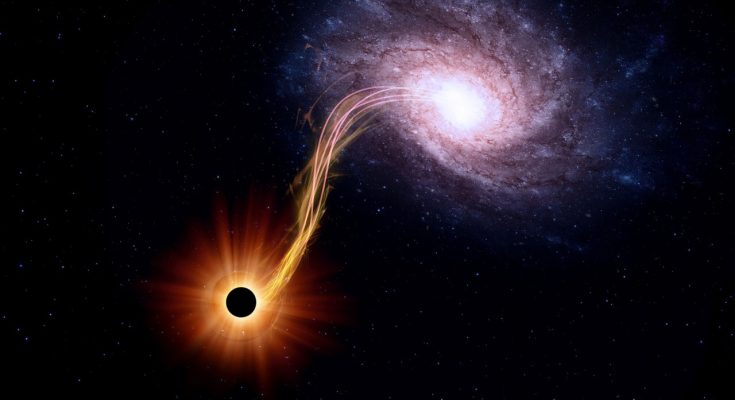Black Holes : To a closer look at the unstoppable force of black holes, the mind-blowing power of these cosmic vortices that continue to captivate and intrigue scientists and space enthusiasts alike. These enigmatic objects, with their immense gravitational pull and ability to swallow anything in their path, have long been a source of fascination and wonder. In this book, we will delve into the depths of black holes, exploring their origins, properties, and the latest research surrounding them. Get ready to embark on a journey through the mysterious and awe-inspiring world of black holes, and discover the unstoppable force that lies within.
Formation and Evolution of Black Holes: Exploring the Origins of These Enigmatic Cosmic Objects
The formation of black holes is closely tied to the life cycle of stars. Stars are born from vast clouds of gas and dust, and as they grow and mature, they generate energy through nuclear fusion. This energy keeps the star stable and prevents it from collapsing under its own gravity. However, when a star runs out of fuel, it can no longer produce enough energy to counteract its own gravity, and it begins to collapse.
For smaller stars, this collapse can be halted by the repulsive force of electron degeneracy pressure, which prevents the star from collapsing into a singularity. These stars then become white dwarfs, which are dense objects but are not considered black holes. However, for larger stars, the collapse cannot be stopped, and they continue to shrink until they become what is known as a neutron star. These objects are even denser than white dwarfs and have a strong magnetic field, but they are still not black holes.
To form a black hole, a star must be at least three times more massive than our sun. As the star collapses, it becomes so dense that not even light can escape its gravitational pull. This point of no return is as the event horizon, and it marks the boundary of a black hole. Beyond this point, the gravitational pull is so strong that even time and space are distorted, and nothing, not even light, can escape.

But black holes are not just formed from the collapse of stars. There are also supermassive black holes, which are found at the center of most galaxies, including our own Milky Way. These black holes are millions or even billions of times more massive than our sun, and their origins are still a mystery. One theory suggests that they formed from the merging of smaller black holes, while another proposes that they were formed in the early universe, during the rapid growth of galaxies.
As black holes continue to grow, they can also merge with other black holes, creating even larger and more massive objects. This process is thought to be responsible for the formation of supermassive black holes, as well as the production of gravitational waves, which were first detected in 2015.
The evolution of black holes is also a subject of ongoing research. As they continue to consume matter and merge with other black holes, their mass and gravitational pull increase. This can have a significant impact on their surroundings, as they can influence the movement of stars and gas in their vicinity. In some cases, this can lead to the formation of accretion disks, where matter spirals into the black hole, emitting powerful radiation in the process.

Black holes also play a crucial role in the evolution of galaxies. As they grow, they can release enormous amounts of energy, which can affect the formation of new stars and the overall structure of the galaxy. They are also thought to be responsible for the creation of quasars, which are some of the brightest objects in the universe.
In conclusion, the formation and evolution of black holes are complex and fascinating processes that are still not fully understood. From the collapse of massive stars to the merging of supermassive black holes, these enigmatic objects continue to surprise and challenge our understanding of the universe. With ongoing research and advancements in technology, we are getting closer to unraveling the mysteries of black holes and gaining a deeper understanding of their origins.
The Unstoppable Force: Understanding the Incomprehensible Power of Black Holes
The Role of Black Holes in the Life and Death of Stars: A Closer Look at the Cosmic . Stars are born from vast clouds of gas and dust, known as nebulae. These clouds are constantly collapsing under their own gravity, forming dense cores that eventually become stars. As the core of a star grows, it becomes hotter and denser, and nuclear fusion reactions begin to take place. This is the process that powers a star, as hydrogen atoms fuse together to form helium, releasing a tremendous amount of energy in the process.
As a star ages, it will eventually run out of hydrogen fuel in its core. At this point, the star will begin to expand and cool, becoming a red giant. Depending on the size of the star, it may go through several stages of expansion and contraction, until it reaches a critical point known as the Chandrasekhar limit. This is the maximum mass that a white dwarf star can have before it collapses under its own gravity.
When a star reaches the Chandrasekhar limit, it will undergo a catastrophic collapse, triggering a supernova explosion. This is one of the most powerful events in the universe, releasing an immense amount of energy and creating heavy elements that are essential for life. But what happens to the core of the star after the supernova?
If the core of the star is less than three times the mass of the sun, it will become a neutron star. These incredibly dense objects are made up of tightly packed neutrons and are only about 10-20 kilometers in diameter. But if the core is more massive than three times the mass of the sun, it will continue to collapse, forming a black hole.
Black holes are regions of space where the gravitational pull is so strong that nothing, not even light, can escape. They are invisible to the naked eye, but their presence can be detected by the effects they have on their surroundings. As matter falls into a black hole, it forms an accretion disk, where it spirals around the black hole before being consumed. This process releases a tremendous amount of energy, making black holes some of the brightest objects in the universe.
But what is the role of black holes in the cosmic cycle? Black holes play a crucial role in recycling matter in the universe. As stars die and their matter is pulled into black holes, it is compressed and heated to extreme temperatures. This matter is then ejected back into the universe through powerful jets, enriching the surrounding space with heavy elements and providing the building blocks for new stars and planets.
Black holes also play a vital role in regulating the growth of galaxies. As matter falls into a black hole, it releases a tremendous amount of energy, which can disrupt the formation of new stars in the galaxy. This process, known as feedback, helps to maintain a balance between the growth of galaxies and the consumption of matter by black holes.
In conclusion, black holes are not just mysterious and fascinating objects in the universe, but they also play a crucial role in the cosmic cycle. From the birth of stars to their death and the recycling of matter, black holes are an essential part of the ongoing process of creation and destruction in the universe. As we continue to study and learn more about these enigmatic objects, we will undoubtedly uncover even more secrets about their role in the grand scheme of the cosmos.
Read More: The Best Cheap Auto Insurance in Pennsylvania 2022 – Su Android Tech




